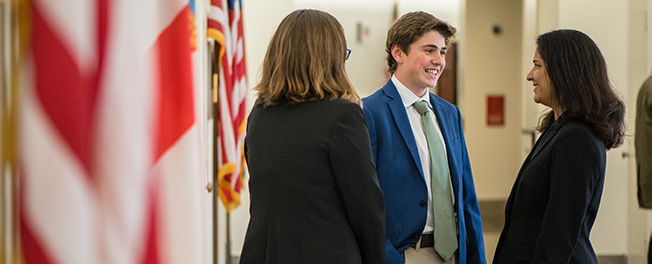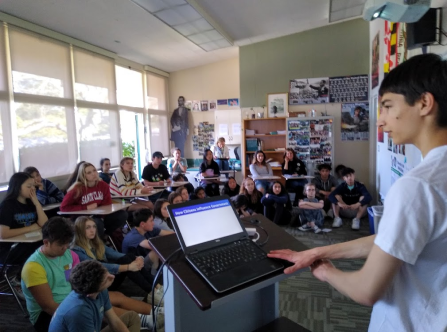
Spark of Change: The Great School Electrification Challenge
By: Veda Ganesan
The phrase “electrification” is a common topic nowadays, especially in the context of buildings. Electrification plays a pivotal role in the process of reducing carbon emissions from our buildings, while still being cost-effective. Did you know that schools are among the largest consumers of energy in the public sector? They generate emissions equivalent to those of 18 coal-fired power plants or 15 million cars each year. For that reason, tackling school electrification is a significant step to cleaning our air and environment.
In an age where sustainable living and cutting-edge technology are paramount, it’s only fitting that our educational institutions join the movement. Enter “The Great School Electrification Challenge”, a beacon of innovation, sustainability, and activism inspiring green changes in local school districts.
The challenge to “electrify everything” in schools is a campaign started by the National Youth Action Team (NYAT) of Citizens’ Climate Lobby. Much of the support and background for this campaign is provided by Rewiring America through their “Electrify Everything in Your School” guidelines.
As students, we hold a unique position as the primary users of school facilities, giving us the right and influence to advocate for these changes. Taking part in the “Great School Electrification Challenge” might be the most impactful way to directly reduce carbon emissions. By transitioning school energy systems to sustainable sources, installing solar panels, and electrifying the school bus fleet, school districts can significantly reduce our country’s carbon footprint. These changes also contribute to a safer, more comfortable school environment, as they increase air quality, and thus promote cognitive development.
Though ambitious, the goal is that by April 30th, 2024, at least fifteen school boards across the U.S. pledge to “electrify everything” in their school districts. If just 15 schools start, we will surely see a wave of electrification across infrastructure in the United States.
According to Sharon Bagatell, the CCL Youth Action Coordinator, “schools are one of the largest public sector consumers of energy, so getting them to switch to clean electric energy can have a big impact on our national greenhouse gas emissions. And who better to ask for that change than the students who use those buildings and buses on a daily basis? At the same time, participating in a Challenge is a fun, informative, and empowering way for students to engage their communities in the national shift to clean electric energy.”
Origins of the Challenge
So how did the “The Great School Electrification Challenge” start? The electrification challenge was initiated by the 2022-2023 NYAT Leadership: Aili Scott, Rama Mhaskar, Franklin Wu, and Nathan Paul. CCL has a history of lobbying, conducting grassroots outreach, and more, but the new Great Electrification Challenge allows all students to directly address a problem they face first-hand on a daily basis through resolution writing, advocacy, and hands-on outreach. Since schools are major contributors to greenhouse emissions, tackling their energy usage is a step toward green reform. Through the challenge, students are their own leaders as they navigate the ups and downs of advocacy in the public sector.
Tahoe Youth Action Team
Members of the Tahoe Youth Team took that to heart last spring as they launched their school electrification campaign. In true CCL style, they used the “5 Levers” to guide their campaign. They have researched their school board and the district’s energy plan, drafted a resolution, spoken at local school board meetings, conducted tabling events, written op-eds, sought endorsements for their resolution, and built relationships along the way. Team Leader Keira Scott, in a presentation at the CCL National Conference in June, shared some learnings and some recommendations: “persevere with a purpose while being patient and respectful, get your community involved early and show that your proposal has a lot of general support, and stay connected with other climate advocates who are doing similar work.”
For teams beginning the electrification challenge, Keira suggests that members should persevere with a purpose while being patient and respectful. Here are a few tips from the TYAT team:
- Dedicate a long meeting to plan out your entire process.
- Use all available resources such as the “Carbon Neutral Schools Resolution Template” from NBI or the Great School Electrification Challenge Guide provided by CCL.
- Do research on what your district has already done in terms of sustainability, energy efficiency, and electrification.
- Get your community involved early and show that your proposal has a lot of general support!
- Be respectful when communicating with your school board but don’t hesitate to follow up often.
- Do your best to get press coverage about your team, resolution, and actions.
- Stay connected with other climate advocates who are doing similar work!
Getting Started
Ready to get going? Join us in urging your school district’s Board of Education to pass an “Electrify Everything” Resolution. Plus, you can earn points by taking action in various steps to create a resolution and promote electrification. For more information and detailed instructions, consult the Great School Electrification Challenge Guide.
To get started, form a team of 3+ students and find an adult sponsor. Then register for the Challenge. Along the way, you’ll work with your team to draft a resolution, conduct outreach activities, build community engagement and support, and present at school board meetings. That’s all it takes! If you have any questions, contact .
It’s normal to feel daunted by such ambitious tasks but remember that there is a network of fellow advocates supporting you and your electrification journey. Throughout the year, CCL Youth will hold periodical conferences to aid in resolution writing and presentation; the highlight of “The Great Electrification Challenge” is that you have a network of passionate youth and leaders supporting your electrification journey along the way.
To me, as a high school student, “The Great Electrification Challenge” is more than just structural; it is a symbol of our commitment to a brighter, greener, and more sustainable future. The Challenge empowers students to be forward-thinkers, innovators, and environmental stewards. As we continue to build and retrofit schools around the country, let us be inspired to pursue the change we wish to see, regardless of how daunting it may seem.
Veda Ganesan is a sophomore at Marcus High School in Flower Mound, Texas. She is an avid member of the National Communications and Social Media team of the NYAT. Veda is also co-founder of a youth climate advocacy group and is producer/host of her green investing podcast, Sustainable Cents.




